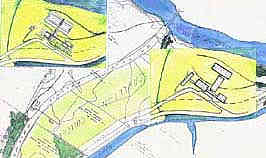Initial Master plan - continued
The image shown below consists of a composite of four cartographic images brought together, three from the architect's 1953 plans
and one previous topographic map of the site. It illustrates the two preliminary concepts of Balharrie. One
scheme consisted of five interconnected buildings; the other three. The latter scheme incorporated the arts and
sciences activities into a long structure with a large, enclosed central area, much like the interior courts one
might find in today's shopping malls. That main building was to have been nearer the river below the other campus
structures.
At their next meeting the executive committee approved a building committee to advise on the "development of the
new campus site layout and facilities required for such specified buildings and such other matters as the
landscaping and beautification of the campus"
Historical evidence suggests no further action was taken by architects and planners for nearly
a year. This hiatus may have been a result of unresolved expropriation intentions by the Federal District Commission.
During 1953 the College tried repeatedly to have the FDC's resolution to expropriate rescinded. The conflict
involved personalities, local issues, and ultimately issues within the federal government. Finally, it seems
to have become clear Carleton's support within the federal cabinet was sufficient to overturn decisions at the
regional or local level.
 |  |

 | Balharrie plans (1953) : two campus
plan schemes |
| Carleton University Library, Special Collections and Archives
|
The FDC's power of expropriation was dependent upon cabinet approval.
In October 1953, as part of the many arguments presented
to the FDC during the year, Coyne and MacOdrum had stated: "It is the firm belief of those entrusted with the destinies
of Carleton College that the establishment of a well-planned university on this campus will not detract from, but
rather much enhance the prospects of the National Capital Plan for the beautification and improvement of the City
of Ottawa." (Correspondence, 14 October 1953, p.4)



